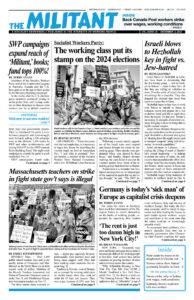NEW YORK — Persistently high rents and home mortgage prices make it increasingly difficult for working people to live here. And workers face similar situations in growing numbers of cities and rural areas across the country.
“Why ‘Affordable Housing’ in New York City Can Still Cost $3,500 a Month,” headlined a New York Times article Nov. 12, the first in a series on “The Housing Crunch.” But what city authorities dub as “affordable” is out of reach for the vast majority of the working class.
Some 500,000 households — more than twice the number in the entire city of Miami — spend at least half of their monthly income on rent. Overall, renters in New York pay around 38% of their income on rent. And New York’s median rent is nearly double that in the rest of the country.
Only 1.4% of New York City apartments were available to rent last year, the city government reports. And landlords take advantage of the competition this engenders to keep jacking up rents. With a nationwide shortage of some 1.5 million housing units, rents have gone up 47% and home prices leapt 26% since 2020. It’s worse here. Many people have had to cram together in thousands of overcrowded “illegal” basement and cellar apartments that are prone to flooding and at greater risk of fires.
Rosanna Glasgow, 37, a member of the Service Employees International Union, earns $19 an hour working at Kennedy airport. She lives with her mother and her brother, a welder, in the Rockaways in Queens, paying $2,600 a month for a three-bedroom apartment. With the heat in the building not working and the landlord refusing to fix it, she told the Times she has been looking for months for a new place to live, but can’t find a comparable apartment that costs less than $3,600 a month. “I don’t know what’s going to happen,” she said.
More than half of workers and their families here lack enough income to cover basic needs — housing, food, child care, transportation and health care — the United Way of New York City and Fund for the City of New York reported earlier this year. This is a big jump from 2021, when the two groups reported just over a third of city households faced this dire reality.
This housing crisis is reflected in startling statistics on homelessness facing large numbers of children who go to public school in New York. At least 146,000 students, about one in eight, didn’t have a regular place to live at some point during the past school year, a 23% increase from the year before. The number of homeless students in New York City has topped 100,000 for nine straight years.
The median household income in the city is around $70,000 this year. But that’s not enough to cover rent and other essentials. And even this median figure hides the sharp class differentiations workers face. The wealthy and those in the upper middle class have no problems affording expensive condos or renting luxury apartments. Newspapers like the Times publish slick magazines with pages of ads for homes at $10 million. For workers, the ones who keep the city running, these look like a sick joke.
The stark reality workers face
Two of the biggest job sectors in the Big Apple are restaurant workers and home health aides. Aide jobs are the fastest growing job market in the city, currently providing 309,000 jobs, overwhelmingly for women. Their minimum wage is just over $18 an hour. There are 322,000 restaurant workers, with a high proportions of immigrants, many stuck at the city’s legal minimum wage of $16 an hour.
At that pay, to rent a one-bedroom apartment for $2,330 a month would take up to 84% of your income. You could forget about feeding a family, much less pay for electricity or Wi-Fi.
The fight against high rents and mortgages is one of the key issues confronting the working class. In Cuba, it took a revolution that brought the working class to power to begin to resolve this. Fidel Castro, the central leader of the Cuban Revolution, took this up in a speech he gave to the United Nations General Assembly in September 1960, which is available in the Pathfinder book To Speak the Truth.
“The revolutionary government began to take its first steps. The first was a 50% reduction in rents paid by families,” he said. “There were families paying up to one-third of their income for rent. The people had been the victims of housing speculation. …
“The people rushed into the streets rejoicing, as they would in any country — even here in New York — if rents were reduced by 50% for all families.”
We need something like that here.

